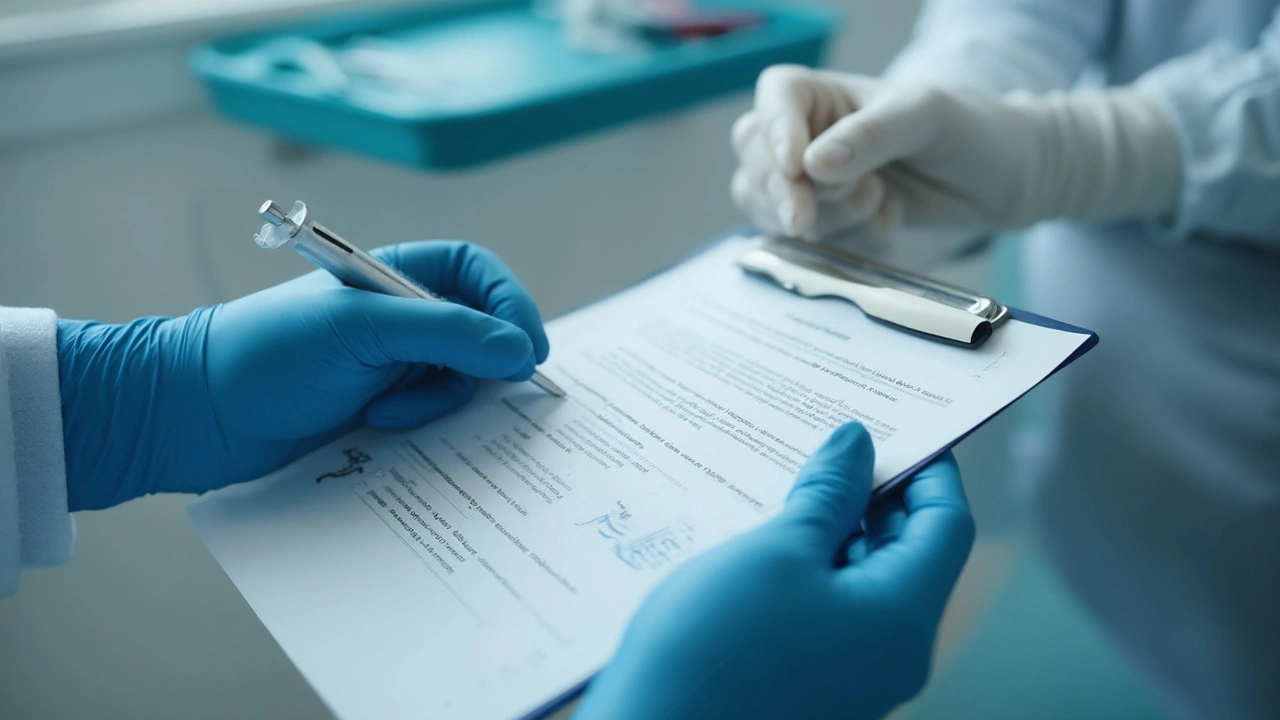Why Informed Consent for Local Anesthesia in Dentistry Matters More Than Ever
 Jun, 5 2025
Jun, 5 2025
It’s easy to assume numbness from a shot at the dentist is no big deal—just routine, right? Well, hang on. Imagine sitting in that chair, trusting someone with sharp tools inside your mouth, and suddenly realizing you don’t totally understand what’s happening or the risks involved. Most of us have signed those forms without much thought. But what’s actually at stake when it comes to local anesthesia? A lot more than most people realize.
Unpacking Informed Consent: It’s More Than a Signature
Let’s clear up a huge myth: informed consent isn’t just about scribbling your name on a clipboard before someone jabs your gums. The real deal runs much deeper—it’s supposed to be an honest conversation where you get to ask questions, understand options, and actually feel comfortable saying yes or no. In short, informed consent means you and your dentist need to be on the same page, fully.
Dentistry might not seem as dramatic as open-heart surgery, but local anesthesia can come with its own risks that demand attention. Lidocaine and other numbing agents can trigger allergic reactions in some people—ranging from mild skin rashes to the extreme, like swelling of the face or even trouble breathing. These cases are rare, but not unheard of. There are also ‘needle phobia’ cases, fainting spells, and more than a handful of stories where a patient's medical history wasn’t fully covered, causing big trouble after a seemingly routine shot.
It’s legally and ethically required for dentists to be honest about possible reactions and complications, even if the likelihood is slim. But consent isn’t just about covering the dentist’s legal bases. According to a survey by the American Dental Association from early 2024, 37% of dental malpractice cases involved patients claiming they didn’t fully understand what anesthesia would do, or what could go wrong. That’s a huge chunk—especially when you consider that the actual risk of something going seriously wrong is a tiny fraction of all cases.
Being informed means knowing more than what’s in the fine print. Say you’re getting a numbing injection for a filling. Does your dentist explain how long it’ll last, how your face might feel, or reassure you that you won’t bite your cheek to bits while you’re still numb? Sometimes, all you get is “Okay, open up.” If your dentist doesn’t spell out that you’ll lose feeling for a few hours, that there’s a small chance of nerve injury (which, yes, can take weeks to heal), or that some people experience tingly numbness or mild pain after the anesthesia wears off, then you aren’t truly informed.
And let’s talk about individual concerns. Someone with a heart issue, for example, needs to know which anesthetic contains epinephrine—a common ingredient that can, in rare cases, cause heart palpitations or blood pressure spikes. People who’ve had previous negative reactions, who are pregnant, who take regular medication, or are on blood thinners need totally different details and steps for a safe procedure.
So, if you’ve ever felt awkward or rushed when trying to voice your worries, you’re not alone. A lot of people freeze up in the dentist’s chair and assume the pro knows best. But here’s the thing—you have every right to fully know what’s being done, and to get clear, honest answers. Good dentists will take the time to explain, and that talk is what builds true trust.

What Real Informed Consent Looks Like in Dental Practice
Picture this: you walk in for a cavity filling and, before anything happens, the dentist sits down eye-level with you. You get a quick rundown, not a lecture: Here’s the plan, here’s why we’re using anesthesia, here’s the name of the drug, here’s what might happen, and here’s what could very rarely go wrong. You get space to ask questions—what if I react badly? When will my face feel normal? Can I drive home right after? And you get honest answers, not vague reassurances.
Sounds obvious, but it isn’t always the reality. In some busy practices, this chat can fall through the cracks. In the worst cases, patients don’t realize they could pause or say no at all. They leave feeling confused, rushed, or unsure. That’s where serious problems start to snowball. Dental boards and patient safety advocates say most medical lawsuits boil down to one big issue: lack of real, clear communication.
So what’s required for informed consent under U.S. law? Not as much as you’d hope. Most states say the dentist needs to explain the procedure, its risks, benefits, and any alternatives—even if those alternatives mean “do nothing.” The dentist also has to ask about your health history, allergies, or current medications. But, there’s plenty of gray area about what that really looks like. Some patients get handed a paper with a dozen words nobody ever says out loud. Others get a friendly, detailed chat. Which feels safer?
There’s more at play here. Technology is changing things—more practices now use digital forms with pre-recorded explanations, so patients can review info on tablets or smartphones before an appointment. But research by the Journal of Dental Education in late 2023 found that patients who had one-on-one, face-to-face explanations remembered their consent info almost twice as well as those who only were handed forms or videos. The human touch still matters, a lot.
Here’s a handy checklist that every dental office should cover in their consent process—feel free to use this for your own appointments:
- Why local anesthesia is being recommended (not just “to numb pain,” but exactly what will be numb and how long it lasts)
- The name of the anesthetic, and whether it contains specific additives like epinephrine
- Possible side effects (swelling, numbness, tingling, infection risk, allergic reaction, rare nerve damage)
- Immediate steps if something feels wrong during or after the shot
- Whether you should avoid driving, eat soft food, or avoid hot drinks post-procedure
- Longer-term symptoms that require a return call or checkup (like lingering numbness after a day or two)
- Alternative methods for pain control—like “numbing gels” or trying no anesthesia if the cavity is shallow
- Any post-anesthetic complications you’re at higher risk for (if you’re pregnant, taking blood thinners, or have medical allergies)
Little details can make a huge difference. For example, most numbness wears off after 1-3 hours, but some people (kids especially) may be numb for longer and risk chewing on their lips or cheeks without realizing. Teens and adults may want to drive after a procedure, but that’s not always smart if you’re still drooling or can’t feel one side of your mouth. Just ten seconds of extra explanation could save a painful—sometimes even embarrassing—experience.
Here’s a snapshot showing how often various complications actually happen. Don’t let the numbers scare you, just know what’s possible—and remember, real informed consent means being prepared for all of them, even if they’re uncommon:
| Complication | Estimated Rate | Typical Outcome |
|---|---|---|
| Allergic reaction | 1 in 25,000 | Usually mild, rare severe cases |
| Nerve injury | 1 in 13,800 | Numbness a few hours to weeks |
| Accidental Injection into Blood Vessel | 1 in 10,000 | Dizziness, rarely serious |
| Persistent swelling | 1 in 18,000 | Resolves in days to weeks |
| Temporary facial weakness | 1 in 9,000 | Usually recovers in hours |
There’s nothing scary here for most, but if you’re that “one in” statistic, you’ll be glad you knew what to expect. Knowledge isn’t just power, it’s peace of mind.

Building Trust and Comfort Through Real Communication
The magic happens not just in paperwork, but in real conversations. Ever feel that little pit in your stomach before a dental visit? You’re definitely not the only one. Studies by the National Network for Oral Health Access in 2024 show that almost 60% of dental-phobic adults would feel less anxious if their dentist simply took five extra minutes to explain and listen before a procedure—even for local anesthesia.
Here’s why: being respected and really listened to changes the whole vibe. You’re not a set of teeth—they see your whole self. You can share your concerns or allergies from the start, know you won’t be rushed, and feel like your worries matter. That kind of interaction lowers stress and makes the whole procedure easier for everyone. Dentists can spot red flags early, adjust their technique, or even pick a different drug. Trust is a two-way street.
Communication tips aren’t just for dentists. Patients can (and should) speak up too! If you hate needles, tell them. If you have a weird tingly reaction to numbing shots, report it early on. Keep a quick record of past reactions or allergies on your phone so you don’t have to remember everything on the spot. Share any medical conditions—not just the major stuff, but minor concerns like frequent cold sores (certain procedures could trigger an outbreak near a numbed area).
It helps to ask questions in your own words, even if you feel silly. Try, “How numb will I be, and for how long?” or “Can I eat right after?” And if you ever feel rushed, ask them to slow down. No respectful provider will mind—if anything, they’ll appreciate it. Open conversations aren’t just safer, they make the process more human and way less nerve-wracking.
Here’s a quick tip-list for patients to get more from their visit:
- Write down your concerns and questions before your appointment, so you don’t forget under pressure.
- Mention your full medical history—including recent colds or infections—not just chronic illnesses.
- Say if you’ve had unusual feelings from shots before (weird tastes, pounding heart, lightheadedness).
- Ask the dentist to restate things in simple language if you don’t get it the first time.
- Don’t be afraid to say “I’m not ready” or “Can we talk more about this?” if you feel unsure.
There’s also the cool, practical side: new anesthetics are coming out that last shorter (or longer), trigger fewer reactions, or feel less stingy going in. Dentists can match the right drug—not just to the tooth, but to your unique needs—if everyone communicates clearly. Without informed consent, patients miss out on these tailored improvements.
The bottom line? Informed consent for local anesthesia isn’t about scaring patients or piling on paperwork. It’s about partnering for safer, better outcomes. Open communication shrinks stress, closes gaps for rare but real issues, and keeps everyone in the loop. Numbing a tooth might seem routine, but the trust and care that come from true consent? That’s what turns a tough visit into a positive, safe experience—for both sides of the chair.
Tina Dinh
June 14, 2025 AT 17:41I literally cried reading this 😭 I thought my dentist was just being efficient... turns out I was being gaslit with a syringe. Never signing another form without asking about epinephrine again. 🙌
Andrew Keh
June 16, 2025 AT 07:55This is an important topic that deserves more attention. Informed consent is not a formality-it is a fundamental part of ethical medical practice. Patients should always be given clear, understandable information before any procedure.
Peter Lubem Ause
June 17, 2025 AT 06:45As someone from Nigeria where dental care is often rushed or under-resourced, I can say this applies everywhere. Even in places with fewer resources, the principle of informed consent matters. A simple conversation-'This shot has epinephrine, it might make your heart race a bit'-can save someone from panic. It’s not about complexity. It’s about dignity. And yes, I’ve seen people faint because they didn’t know what was coming. Don’t underestimate the power of three sentences spoken kindly.
linda wood
June 18, 2025 AT 20:13Oh wow, so the dentist just says 'open up' and that’s consent now? 🤡 I’m shocked. Shocked I tell you. Next they’ll start giving me surgery and call it 'a quick fix.' Also, why is it always the patient’s job to know the risks? Shouldn’t the person holding the needle be the one explaining it? Just saying.
LINDA PUSPITASARI
June 19, 2025 AT 10:45YES YES YES I’ve had that weird tingly feeling after a shot and no one ever told me it could last days 😭 I thought I was having a stroke. Ask for the name of the anesthetic. If they don’t know it, walk out. Also-use numbing gel first if you’re scared. It’s a game changer. And no, you don’t have to be quiet in the chair. Speak up. Your mouth, your rules 💪
gerardo beaudoin
June 20, 2025 AT 23:56My dentist actually sat down with me and went through this checklist. I didn’t even know I could ask about alternatives. He said 'we can do it with a gel if you’re nervous.' I cried. Not because it hurt-because someone finally treated me like a person.
Joy Aniekwe
June 21, 2025 AT 23:44Oh please. You’re telling me people don’t know what a needle does? Did you grow up under a rock? This is basic. Also, why is this even an article? The real issue is that dentists are overworked and underpaid. Blame the system, not the provider.
Latika Gupta
June 23, 2025 AT 13:46Do you think this applies to me? I’m from India and my dentist never asked about my thyroid meds. Should I be worried? Can I send him this article? I’m scared to ask. I don’t want to seem rude. What if he thinks I’m difficult?
Sullivan Lauer
June 23, 2025 AT 20:21Let me tell you what happened to my cousin. She got the shot, didn’t know about epinephrine, had a heart palpitation so bad she called 911. They thought she was having a heart attack. Turned out it was just the anesthetic. She’s been terrified of dentists ever since. This isn’t just about paperwork-it’s about saving lives. People need to wake up. This isn’t a drill. This is real. I’m not exaggerating. This is life or death.
Sohini Majumder
June 25, 2025 AT 07:42OMG I’m so done with this... why is everyone making such a big deal about a needle? I mean, come on. It’s just a little pinch. And who even reads these forms? I just want my cavity fixed. Also, I think this post is way too long. Like, 1000 words for a tooth? 🙄
tushar makwana
June 25, 2025 AT 21:56My father, he was dentist in India, he say always explain, even if patient not ask. Because fear is real. Even if you think they know, they don’t. Small talk, small words, big difference. I still remember my first shot-he said, 'This will make your lip sleep, like pillow.' I laughed. Then I wasn’t scared anymore. That’s consent. Not paper. Heart.
Richard Thomas
June 26, 2025 AT 02:03The notion that informed consent is somehow lacking in contemporary dental practice is a mischaracterization of a highly regulated profession governed by state medical boards, professional ethics codes, and liability protocols. The data cited, while statistically significant, does not account for the overwhelming majority of procedures conducted without incident. The emotional framing of this article is disproportionate to the objective risk profile of local anesthetic administration.
Matthew Higgins
June 26, 2025 AT 23:25Bro. I had a dentist tell me he was gonna use 'the numby stuff' and that was it. I thought that was normal. Then I bit my tongue for three days. I’m not mad. I’m just… disappointed. Like, we can do better. Also, I now ask for the name of the drug. They always look confused. It’s kinda funny now.
Mary Kate Powers
June 27, 2025 AT 12:48You’re not alone. I used to be terrified of dentists too. But when I started asking questions-'What’s in this?' 'How long will I be numb?' 'Can I drive?'-I realized most dentists actually want to help. They just don’t always know how to explain it. You’re not being annoying. You’re being smart. Keep going.
Sara Shumaker
June 28, 2025 AT 00:35It’s fascinating how we’ve turned trust into a transaction. We hand over our bodies, our vulnerability, and expect professionalism-but we never ask what it costs the provider to truly listen. What if consent isn’t about what’s said, but what’s felt? Maybe the real risk isn’t the needle… it’s the silence.
Scott Collard
June 29, 2025 AT 09:56Most patients are too lazy to read the form. That’s on them. Stop coddling people. If you don’t know what lidocaine is, Google it. This isn’t kindergarten.